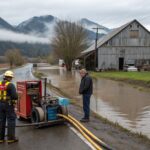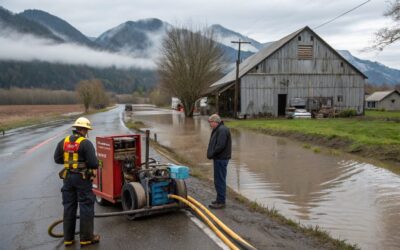Introduction: Woodburn’s Winter Weather Challenge
Situated in the heart of the Willamette Valley, Woodburn, Oregon experiences a unique set of winter weather challenges that distinguish it from other Portland metro communities. While the city may not see the heavy snowfall that affects higher elevations in the region, Woodburn is particularly vulnerable to ice storms and freezing rain – some of the most destructive winter weather phenomena. The city’s location in a transitional climate zone, where warm Pacific moisture meets cold continental air masses, creates perfect conditions for these dangerous weather events.
At Pacific Water & Fire Restoration, we’ve worked extensively with Woodburn property owners during and after winter weather emergencies. We’ve witnessed firsthand how the city’s proactive approach to infrastructure protection and community preparedness has evolved, especially following significant events like the 2021 ice storm that left thousands without power for days and caused millions in property damage across Marion County.
This blog explores Woodburn’s comprehensive strategy for managing winter weather threats, offering valuable insights for both residents and business owners on how to protect their properties and ensure safety when winter’s fury strikes.
Understanding Woodburn’s Winter Weather Risk Profile
The Science of Ice Storms in the Willamette Valley
To understand Woodburn’s approach to winter weather management, it’s important to first recognize why this area is particularly susceptible to ice storms and freezing rain. Several geographic and meteorological factors contribute to this risk:
- Valley Location – Woodburn’s position in the Willamette Valley creates a topographical basin where cold air can become trapped beneath warmer air aloft
- Proximity to the Columbia Gorge – Cold easterly winds from the Columbia River Gorge can funnel into the northern Willamette Valley
- Marine Influence – Moist air from the Pacific Ocean provides ample precipitation that falls into cold air near the surface
- Temperature Threshold Vulnerability – Woodburn frequently hovers near the freezing mark during winter storms, a critical threshold where rain becomes freezing rain
According to the National Weather Service Portland office, the Woodburn area experiences freezing rain events about 3-5 times per winter season, with major ice accumulations (greater than 0.25 inches) occurring approximately once every 3-4 years. This frequency significantly exceeds the regional average for comparable-sized communities.
Historical Impact on Woodburn’s Infrastructure and Properties
Woodburn has faced several significant winter weather events that have shaped its current approach to preparedness and response:
- December 2008 Arctic Blast – Brought nearly a week of subfreezing temperatures and multiple ice storms, causing widespread power outages and water pipe failures
- January 2017 Ice Storm – Resulted in up to 0.75 inches of ice accumulation, damaging trees throughout the city and causing power disruptions for over 40% of residents
- February 2021 President’s Day Ice Storm – One of the most destructive in recent history, with ice accumulations exceeding 1 inch in parts of Woodburn, leading to catastrophic tree damage, power outages lasting up to a week, and significant property damage
These events have highlighted specific vulnerabilities in both public infrastructure and private properties. Data from the City of Woodburn Public Works Department indicates that approximately 65% of reported property damage during ice storms falls into three categories:
- Roof and gutter damage from ice dam formation and falling debris
- Water damage from pipe bursts and ice-related water intrusion
- Structural damage from fallen trees and limbs
Understanding these historical patterns has allowed both the city and property owners to develop targeted preparedness strategies.
Woodburn’s Infrastructure Protection Strategy
Public Works Department’s Proactive Approach
Woodburn’s Public Works Department has implemented a comprehensive winter weather management program that emphasizes prevention and rapid response. Key elements include:
- Annual Infrastructure Assessment – Systematic evaluation of vulnerable infrastructure components before winter season
- Tree Management Program – Proactive trimming of trees near power lines and public facilities
- Priority Route Maintenance – Designated emergency routes receiving enhanced pre-treatment and priority clearing
- Critical Facility Backup Systems – Ensuring water treatment plants and public safety buildings have robust backup power
- Public-Private Coordination – Established protocols for working with utility companies during emergencies
The department maintains specialized equipment specifically for ice events, including salt brine applicators, which are more effective than traditional sand or gravel on icy surfaces. Their winter weather response plan includes specific triggers for deployment based on forecasted conditions rather than waiting until ice has accumulated.
Pro Tip: Woodburn residents can view the city’s priority snow/ice route map on the Public Works website to understand which routes will be cleared first during winter emergencies. This information helps in planning alternative transportation and emergency evacuation routes.
Portland General Electric’s Grid Hardening Initiatives
Following the extensive outages during the 2021 ice storm, Portland General Electric (PGE) has invested significantly in making Woodburn’s electrical infrastructure more resilient. These improvements include:
- Strategic Undergrounding – Placing high-vulnerability power lines underground, particularly in heavily treed areas
- Advanced Insulation – Upgrading power line insulation to better withstand ice accumulation
- Smart Grid Technology – Implementing automated switching systems that can isolate outages and restore power to unaffected areas more quickly
- Targeted Tree Clearing – More aggressive vegetation management along key transmission corridors
- Reinforced Poles and Structures – Upgrading to stronger materials designed to withstand greater ice loads
According to PGE reports, these improvements are expected to reduce winter weather-related outages by approximately 40% and decrease restoration times by up to 30% for affected areas. The utility continues to prioritize hardening efforts in Woodburn due to its historical vulnerability to ice events.
Water System Resilience Measures
Woodburn’s water system faces particular challenges during extended freezing events. The city has implemented several measures to protect this critical infrastructure:
- Improved Insulation Standards – Enhanced requirements for exposed water infrastructure
- Heated Valve Houses – Installing heating systems at critical junction points
- Pressure Management Protocols – Procedures to manage system pressure during freezing conditions to reduce pipe burst risk
- Backup Power Systems – Ensuring water pumping stations can operate during extended power outages
- Public Notification Systems – Enhanced alerts about potential water system issues during freezing weather
The city’s water department now maintains a specialized “frost team” that activates when temperatures drop below freezing, proactively addressing vulnerable components before failures occur.
Property-Level Protection Strategies
Residential Building Winterization
Woodburn residents have developed effective approaches to protecting homes during severe winter weather events. Based on local experience, the most successful winterization strategies include:
- Improved Attic Insulation – Prevents heat loss that can contribute to ice dam formation
- Pipe Insulation and Heat Tape – Applied to vulnerable water lines, particularly on north-facing walls
- Roof and Gutter Maintenance – Regular cleaning and structural assessment before winter season
- Tree Management – Professional evaluation and trimming of trees that could threaten structures
- Backup Power Solutions – From simple generators to more comprehensive systems for longer outages
According to data from insurance claims, Woodburn homes that implement comprehensive winterization measures experience approximately 60% fewer winter weather-related claims than unprepared properties. The average investment in winterization measures typically pays for itself within 3-5 years through damage prevention.
Safety Warning: When using portable generators during power outages, always operate them outdoors at least 20 feet from any window, door, or vent to prevent carbon monoxide poisoning. Never operate generators in garages, even with the door open.
Commercial Property Considerations
Woodburn’s business community faces additional challenges during winter weather events. Successful commercial property protection includes:
- Roof Load Assessment – Professional evaluation of roof structures to ensure they can handle ice accumulation
- HVAC Winterization – Protecting exposed components and ensuring backup heating options
- Plumbing System Draining Protocols – Procedures for draining vulnerable systems if heating fails
- Business Continuity Planning – Developing strategies to maintain operations during extended outages
- Employee Safety Protocols – Clear guidelines for staff safety during winter emergencies
Local businesses have increasingly adopted mutual aid agreements, where neighboring companies share resources and coordinate recovery efforts during severe winter weather. This community-based approach has proven particularly effective for Woodburn’s significant agricultural processing sector, which faces substantial risks from prolonged freezing conditions.
Modern Technology Solutions
Recent technological advancements have provided Woodburn property owners with new tools for winter weather management:
- Remote Monitoring Systems – Allow property owners to monitor temperatures and conditions remotely
- Smart Thermostats – Provide alerts for temperature drops and allow remote control of heating systems
- Water Flow Sensors – Detect pipe breaks early and automatically shut off water supply
- Automated Generators – Provide seamless backup power during outages
- Roof Heat Cable Systems – Prevent ice dam formation on vulnerable roof sections
These technologies are increasingly affordable and accessible, with many local contractors now specializing in their installation. According to Pacific Water & Fire Restoration’s records, properties with monitoring systems typically report ice-related damage 4-6 hours sooner than unmonitored properties, significantly reducing average restoration costs.
Community Preparedness and Response
Woodburn’s Emergency Management System
Woodburn has developed a sophisticated emergency management approach specifically tailored to winter weather threats:
- Tiered Alert System – Progressive notifications based on weather forecasts and conditions
- Warming Center Network – Designated facilities with backup power and heat for vulnerable residents
- Special Needs Registry – Identification and prioritization of residents requiring additional assistance
- Multi-agency Coordination – Integrated response between city services, utilities, and community organizations
- Bilingual Emergency Communications – Ensuring critical information reaches Woodburn’s diverse population
The city activates its Emergency Operations Center when specific winter weather thresholds are forecast, allowing for coordinated preparation before conditions deteriorate. This proactive stance has significantly improved response effectiveness in recent events.
Neighborhood Support Networks
Perhaps the most distinctive aspect of Woodburn’s approach is its emphasis on neighborhood-level coordination:
- Block Captain Program – Designated residents who check on neighbors and relay information
- Resource Sharing Networks – Systems for sharing equipment, supplies, and skills during emergencies
- Vulnerable Resident Check-In Protocols – Formalized process for ensuring elderly and disabled residents receive assistance
- Community Warming Spaces – Homes with generators designated as temporary warming locations
- Coordinated Transportation Assistance – Neighbors with appropriate vehicles helping with essential transportation
These networks operate semi-autonomously during winter emergencies, reducing demands on official emergency services and ensuring more rapid assistance for those in need. The system proved particularly valuable during the 2021 ice storm, when some neighborhoods maintained effective support for five days before official services could reach all affected areas.
Pro Tip: Woodburn residents can register for the Neighborhood Support Network through the city’s emergency management office or online at the city website. This free program connects residents with their local support team and provides basic emergency response training.
Case Study: The 2021 President’s Day Ice Storm Response
The February 2021 ice storm provides a compelling case study of Woodburn’s integrated approach to winter weather emergencies:
Timeline:
- February 11, 2021 – National Weather Service issues ice storm warning; Woodburn activates emergency operations center
- February 12, 10:00 AM – City deploys pre-treatment to priority routes; public messaging intensifies
- February 12, 6:00 PM – Freezing rain begins; neighborhood networks activate phone trees
- February 13, 3:00 AM – Major ice accumulation begins; first power outages reported
- February 13, 8:00 AM – Widespread power outages affect 80% of city; warming centers open
- February 13-17 – Community response networks operate continuously; public-private restoration efforts ongoing
- February 18 – Power restored to 90% of customers; transition to recovery operations
Successful Actions:
- Early Activation – Pre-positioning of city resources before ice accumulation
- Effective Public Communication – Multi-channel, bilingual alerting reached 85% of residents
- Neighborhood Network Effectiveness – Block captains conducted over 1,200 welfare checks
- Public-Private Coordination – Streamlined process for addressing downed trees affecting power lines
- Warming Center Operations – Five facilities operated continuously despite widespread power outages
While the storm’s impact was severe, Woodburn reported no fatalities or serious injuries, despite prolonged freezing conditions and power outages. Property damage, while substantial, was significantly lower than in comparable communities without such comprehensive preparation systems.
Professional Restoration Considerations
When to Call Professionals
Despite the best preparedness efforts, winter weather can sometimes overwhelm preventative measures. Understanding when to call professional restoration services is critical for Woodburn property owners. Key indicators include:
Structural Ice Damage – Ice accumulation causing sagging roof sections or structural deformation
Indoor Water Accumulation – Water from melting ice, burst pipes, or backed-up drainage systems
Mold Concerns – Moisture issues persisting more than 48 hours
Electrical System Damage – Water exposure to wiring, panels, or electrical components
Large-Scale Tree Impacts – Trees or large limbs affecting structural components
Professional assessment becomes particularly important when damage affects building systems or structural elements, as improper repairs can lead to long-term issues like mold growth, structural weakness, or electrical hazards.
The Restoration Process for Winter Weather Damage
When professional restoration becomes necessary, property owners should understand the typical process:
- Emergency Mitigation – Immediate actions to prevent further damage (tarping, water extraction, etc.)
- Comprehensive Assessment – Detailed evaluation of visible and hidden damage
- Moisture Mapping – Identifying all affected areas, including those not visibly damaged
- Controlled Demolition – Removing unsalvageable materials
- Structural Drying – Using professional equipment to thoroughly dry affected areas
- System Restoration – Repairing damaged plumbing, electrical, and HVAC components
- Reconstruction – Rebuilding and finishing damaged areas
For ice storm damage in particular, professional restorers pay special attention to hidden damage in attics, wall cavities, and roof structures where ice damming and water intrusion may have occurred without obvious interior signs.
Pro Tip: Document all damage with photos and videos before any cleanup begins. Pacific Water & Fire Restoration recommends creating a comprehensive visual record that can be critical for insurance claims.
Insurance Considerations for Winter Weather Events
Woodburn property owners should understand several key insurance considerations related to winter weather damage:
- Coverage Variations – Standard policies typically cover burst pipes but may have exclusions for certain types of ice damage
- Maintenance Requirements – Policies often require proof of reasonable maintenance and preparation
- Mitigation Responsibilities – Property owners have a duty to take reasonable steps to prevent further damage
- Cause of Loss Distinctions – Different damage causes (weight of ice vs. water intrusion) may be covered differently
- Professional Assessment Value – Insurance adjusters often give additional credibility to professional documentation
Working with restoration professionals familiar with winter weather claims can significantly improve insurance outcomes. Experienced restorers provide detailed cause-and-effect documentation that clarifies coverage questions and ensures all legitimate damage is included in claims.
Looking Forward: Climate Resilience and Adaptation
Changing Weather Patterns and Implications
Climate data suggests Woodburn may face changing winter weather patterns in the coming decades. Key trends include:
- Increased Temperature Volatility – More rapid swings between warm and freezing conditions
- Higher Precipitation Intensity – Greater rainfall amounts during winter storms
- More Frequent Freezing Rain Events – Potentially more instances of the most damaging winter precipitation type
- Extended Periods of Extreme Cold – Less frequent but potentially more severe cold outbreaks
These trends point toward a future with fewer but potentially more intense winter weather events—a pattern requiring adaptive strategies for both infrastructure and property protection.
Evolving Best Practices for Woodburn Properties
Based on these projections, forward-looking property owners are implementing several adaptive strategies:
- Enhanced Structural Standards – Building beyond current code requirements for ice and wind loads
- Redundant Systems – Multiple heating, water, and power options to prevent catastrophic failures
- Advanced Materials – Using more resilient materials for roofing, siding, and other vulnerable components
- Water Management Improvements – Better drainage systems to handle rapid freezing and thawing cycles
- Landscape Design for Winter Resilience – Strategic placement of trees and structures to reduce ice-related risks
These adaptations represent a shift from reactive recovery to proactive resilience—an approach increasingly embraced by Woodburn’s forward-thinking property owners and city planners alike.
Conclusion: Woodburn’s Winter Weather Resilience Model
Woodburn’s approach to managing winter weather threats provides valuable lessons for communities throughout the Pacific Northwest. By combining infrastructure hardening, property-level preparation, and community-based response networks, the city has created a multi-layered system that significantly reduces both the impact of winter weather events and the recovery time afterward.
The most distinctive aspect of Woodburn’s approach—its emphasis on neighborhood-level coordination and mutual assistance—reflects the community’s understanding that resilience comes not just from stronger infrastructure but from stronger connections between residents. This social infrastructure proves just as valuable as physical improvements when winter’s fury strikes.
As climate patterns continue to evolve, Woodburn’s adaptive, community-centered approach provides a model for how mid-sized communities can effectively manage winter weather threats despite limited resources. By emphasizing preparation, coordination, and mutual support, the city has transformed winter weather from an unpredictable threat to a manageable challenge.
How Pacific Water & Fire Restoration Can Help
As Portland’s trusted restoration experts with extensive experience in Woodburn and throughout Marion County, we offer specialized services for winter weather preparation and recovery:
- Pre-Winter Property Assessments to identify vulnerabilities before freezing weather strikes
- Emergency response planning for homes and businesses
- 24/7 emergency services during winter weather events
- Complete restoration services from initial mitigation through reconstruction
- Documentation assistance for insurance claims
- Preventative winterization services to protect vulnerable properties
Don’t wait until the ice forms. Contact Pacific Water & Fire Restoration today:
- Emergency Services: 503-201-7337 (available 24/7)
- Schedule a Free Winter Readiness Assessment: Visit pacificwaterandfirerestoration.com or call our office
- Learn More: Attend our monthly winter preparedness workshops (details on our website)
Our IICRC-certified professionals are ready to help you protect what matters most during Woodburn’s challenging winter weather season.
Pacific Water & Fire Restoration is a full-service property restoration company serving Portland and surrounding communities including Woodburn. With IICRC certification and 24/7 emergency response, we’re committed to helping property owners before, during, and after disasters strike.









